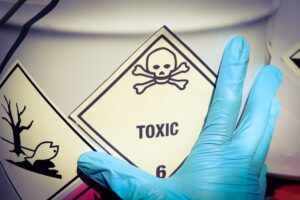How To Claim For Injuries Caused By A Chemical Burn At Work
By Cat Reeves. Last Updated 5th January 2024. Suffering from a chemical burn at work can be painful and distressing. A chemical burn injury can greatly impact your life both physically and psychologically. Employers owe a duty of care to their employees to prevent them from sustaining an injury in the workplace and as they carry out their duties. If you have experienced this type of workplace injury and your employer is liable, you may be entitled to make an accident at work claim and seek compensation, provided you meet the eligibility criteria to do so.

How To Claim For Injuries Caused By A Chemical Burn At Work
This guide first discusses the eligibility requirements you must meet to start a personal injury claim for an accident at work. Later, we provide examples of how chemical burn injuries could be sustained due to an employer’s negligent actions. We also look at the impact these injuries could have and the compensation that could potentially be awarded to address how you were affected.
Then, we provide information on what types of evidence you should try to gather to support your case and how our panel of No Win No Fee solicitors could assist you.
Contact Us
For more information about accident at work claims, please contact an advisor. They can offer free advice 24/7. To reach them, you can:
- Call 020 3870 4868.
- Fill out our ‘Claim Online’ form.
- Use our live chat box below.
Jump To A Section
- How To Claim For Injuries Caused By A Chemical Burn At Work
- How Long Do You Have To Claim For A Chemical Burn At Work?
- Types Of Injuries Caused By Chemical Burns
- How To Prove You Were Injured In The Workplace
- What Could You Claim For A Chemical Burn At Work?
- Can No Win No Fee Solicitors Help You Claim For An Injury In The Workplace?
- Further Guidance On Claiming For A Chemical Burn At Work
How To Claim For Injuries Caused By A Chemical Burn At Work
Under the Health and Safety at Work etc. Act 1974, employees are owed a duty of care by their employer. Employers must prevent their employees from becoming injured at work by taking reasonable and practical steps. Some of the steps they could take to uphold this duty include:
- Providing the correct training so employees can complete their tasks safely.
- Providing necessary Personal Protective Equipment (PPE), such as gloves and eye protection.
- Carrying out risk assessments regularly and implementing measures to address the risk posed by hazards that cannot be removed.
More specifically, the Control of Substances Hazardous to Health Regulations 2002 (COSHH) states that the exposure to materials in the workplace that cause ill health need to be adequately controlled.
Additionally, COSHH states how hazardous substances should be stored, disposed of, and used.
If there is a failure by your employer to uphold their duty of care, and this causes you to sustain a chemical burn at work, you might wonder whether you could make a workplace accident claim.
To do so, you need to meet the personal injury claims eligibility criteria by showing:
- A duty of care was owed to you by your employer.
- Your employer breached their duty of care.
- This breach caused you to be injured.
How Long Do You Have To Claim For A Chemical Burn At Work?
If you suffered chemical burns in an accident at work, you might be wondering how long you have to start a chemical burn injury claim. The time limit for personal injury claims is set out by the Limitation Act 1980, which states that you have three years to start your claim. This begins on the date that you were burned.
However, this time limit comes with some exceptions. For example, if the accident happened while you were under the age of eighteen, the time limit does not begin until your eighteenth birthday. A litigation friend can make a compensation claim on your behalf while the time limit is frozen, or you can start your own claim from your eighteenth birthday. In this case, you will have until your 21st birthday to begin legal proceedings.
Likewise, the time limit does not apply to those who lack the mental capacity to start their own claim. In this case, a litigation friend can make a chemical burn claim on their behalf. If no claim has been made and they regain this mental capacity, they will have three years from the recovery date to begin their own legal proceedings.
Read on to find out how much compensation you could receive for a successful workplace accident claim, or contact our team today to find out if you are within the time limit.
Types Of Injuries Caused By Chemical Burns
A chemical burn injury is usually sustained when a hazardous substance comes into contact with your skin. The severity of chemical burns can range from redness and blisters on the outer layer of the skin to extreme tissue and nerve damage.
Examples of accidents at work that can lead to chemical burn injuries include:
- You are an employee in a warehouse that works with hazardous substances. Your employer does not provide you with the appropriate PPE, such as splash-proof safety goggles or gloves. As a result, the chemicals come into contact with your hands and arms causing severe burns. Additionally, the chemicals splash in your eyes and cause partial blindness.
- As a cleaner in an office building, you are not trained by your employer on how to use products safely. As a result, you mix bleach with ammonia since you are unaware of its effects, meaning you experience severe internal burns to your respiratory system when breathing in toxic fumes.
- Your employer at a leisure centre does not store the pool chlorinator correctly. The chemical is left on its side to leak on the floor of the storage cupboard. As a result, you slip and fall landing in the chemical spill causing you to experience superficial burns to your arms and face.
Please note that not all instances of a chemical burn at work will form the basis of a valid personal injury claim. You would need to prove that your employer’s breach of duty led to you experiencing harm.
Discuss your specific accident at work by getting in touch with an advisor on the number above.
How To Prove You Were Injured In The Workplace
The evidence you gather for your workplace injury claim should show how your employer is liable for the harm you sustained and how any injuries have affected you. Such evidence that is useful to have includes:
- CCTV footage of the incident taking place.
- Photographs of your burn.
- A copy of the log of your accident in the workplace’s report book.
- Copies of your medical records that give details on the treatment you received and what types of burns you had.
- A diary with recordings of your symptoms and well-being following the accident.
- Contact details from other employees if they were witnesses to the accident.
If you are connected to one of the solicitors from our panel, they can help you gather the proof you need for your claim.
To learn whether you could be eligible to instruct an experienced solicitor, don’t hesitate to reach out to an advisor today. After assessing your case and determining your eligibility to seek compensation, they could connect you with a solicitor who has experience handling accident at work claims.
What Could You Claim For A Chemical Burn At Work?
There are up to two heads of claim that can make up a compensation payout awarded following a successful personal injury claim for a chemical burn at work injury.
The first head of claim, general damages, compensate you for the psychological and physical effects of your burn injury. Factors considered when valuing this aspect of your settlement include:
- The severity of the burn.
- The change in your quality of life.
- Any psychological impact.
Your solicitor can work out the value of general damages by using the results from an independent medical assessment, often arranged as part of the claims process, and the Judicial College Guidelines (JCG). The JCG is a document that has different guideline compensation brackets depending on the type of injury.
Injuries Table
| Injury | Guideline Compensation Bracket | Notes |
|---|---|---|
| Multiple Serious Injuries + Special Damages | Up to £200,000+ | Multiple serious injuries combined with financial losses, such as lost earnings and pension contributions. |
| Scarring to other parts of the body | Likely to exceed £104,830 | Serious burns that cover at least 40% of the body. |
| Scarring to other parts of the body | £7,830 to £22,730 | A singular disfiguring or multiple noticeable laceration scars to the legs, arms, hands, chest or back. |
| Facial disfigurement – Very Severe Scarring | £29,780 to £97,330 | Very severe scarring in young people, leaving a severe psychological effect and a very disfiguring cosmetic effect. |
| Facial disfigurement – Less Severe Scarring | £17,960 to £48,420 | Less severe scarring causing substantial disfigurement and a significant psychological reaction. |
| Facial disfigurement – Significant Scarring | £9,110 to £30,090 | Significant scarring that plastic surgery can greatly reduce the worst effects of, and the psychological effect has improved. |
| Lung disease | £31,310 to £54,830 | Difficulties with breathing where a smoky environment cannot be tolerated. |
| Lung disease | £20,800 to £31,310 | Bronchitis and wheezing but no serious symptoms. |
| Injuries affecting sight | £3,950 to £8,730 | Minor eye injury caused by being splashed by liquid or exposed to fumes. |
The compensation table above contains figures from the JCG that accompany different injuries. Please note that all the figures are guidelines only.
Check What Special Damages You Could Claim
The second head of claim, special damages, can only be awarded if you receive general damages. Special damages compensate you for the past and future monetary expenses you have incurred as a result of your chemical burn injury, such as:
- Loss of earnings.
- Medical costs.
- Travel expenses.
Keep hold of any receipts, invoices, payslips, and bank statements as proof of your injury’s financial losses.
You can find out more about what factors go into determining compensation awards for successful personal injury claims by contacting our team on the number above.
Can No Win No Fee Solicitors Help You Claim For An Injury In The Workplace?
You should choose a solicitor from our panel to represent you and help you with your chemical burn at work injury claim, if you are eligible. They offer all of their claimants a Conditional Fee Agreement (CFA), which is a No Win No Fee contract.
When working under a CFA, you do not pay any charges for the work your solicitor does if your claim ends up unsuccessful. You are also not expected to pay these fees for your solicitor’s services before or during the claims process.
Your solicitor will take a percentage of your compensation, known as their success fee, following a successful claim. Legally, there is a maximum percentage solicitors can take as their success fee to ensure you get the most out of your award.
Contact Us
Contact our team today so you can see whether you have a valid workplace injury claim and to receive support strengthening your case. To get in touch, you can:
- Call 020 3870 4868.
- Fill out our ‘Claim Online’ form.
- Use our live chat box.
Further Guidance On Claiming For A Chemical Burn At Work
More of our guides:
- Learn how to prove loss of earnings if you need time off work to recover for your injury.
- Read about how to claim compensation if you have had a serious accident at work.
- Find out what your employer’s responsibilities are after an accident at work.
External resources:
- NHS – A guide on acid and chemical burns.
- Health and Safety Executive (HSE) – Information on what substances are hazardous to health.
- GOV.UK – See if you can claim Statutory Sick Pay (SSP) if you need time off work due to your burn injury.
Thank you for reading our guide on how to make a chemical burn at work claim.
If you have any questions or require any further guidance, please contact an advisor on the number above.



